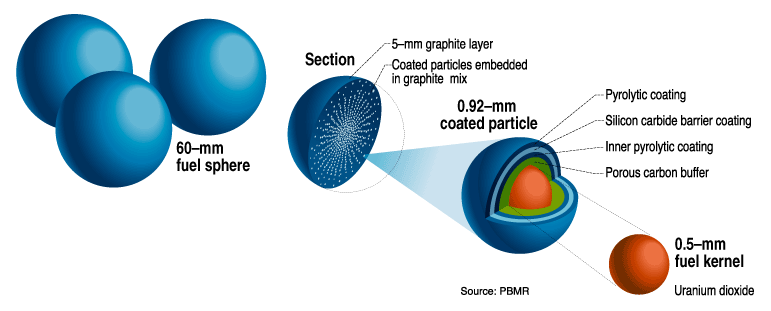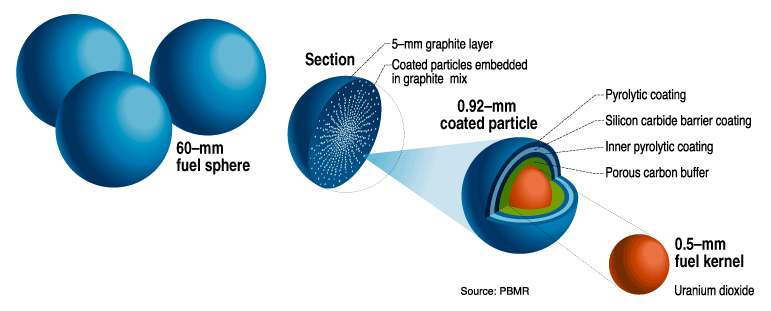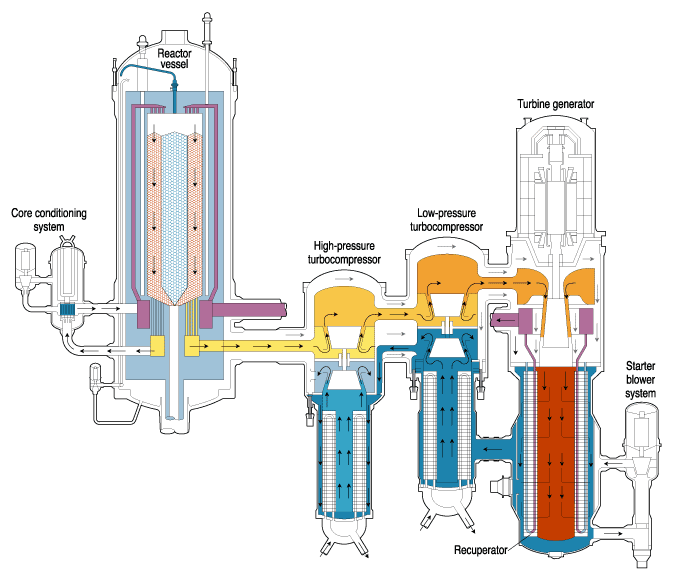Pebble-Bed Design Returns
Could an old design resembling a gumball machine be the next reactor built in the United States?

This is part of IEEE Spectrum's special report: Nuclear Power Gets a Second Look
By next summer, Chicago's Exelon Corp., the largest operator of nuclear plants in the United States, and three international partners will make a decision that could jump-start a nuclear revival. Led by South Africa's state utility Eskom, of Johannesburg, the four will decide whether to continue investing in the pebble-bed modular reactor technology. The concept originated in West Germany in the 1960s and 1970s, and now is experiencing a startling revival.
Specifically, the four companies will decide whether to fund a full-scale prototype pebble-bed reactor in South Africa, at Koeberg, near Cape Town, at the site of Eskom's 17-year-old, twin pressurized-water reactor nuclear station. The other major milestone, assuming the companies give the go-ahead, will come more or less concurrently, by mid-2002, when the South African government is expected to resolve, on the basis of the companies' feasibility and environmental impact studies, whether to allow the construction of a pebble-bed demonstration plant to show the technology works as designed and could be commercialized.
Other evolutionary and exotic reactor concepts continue to be developed in corporate and national laboratories [see "Other Advanced Reactor Concepts"]. But Exelon is, so far, the only nuclear operating company to fully embrace a particular new technology and declare itself committed to building multiple plants if the technology is deemed workable and the economics prove competitive. If the South African pebble-bed project moves ahead, Exelon will seek design certification from the U.S. Nuclear Regulatory Commission (NRC), Rockville, Md., so that the technology could be sold as a standardized, off-the-shelf design, like the three advanced light-water designs already precertified by the NRC [see "Advanced reactor development rebounding," IEEE Spectrum, November 1997, pp. 41-48].
Exelon hopes to submit an application for a pebble-bed modular-reactor license to the commission in late 2002, start construction around mid-2005, and begin operations for the first unit about three years later.
What is pebble-bed technology?
The pebble-bed concept builds on the high-temperature gas-cooled reactor technology developed in the 1960s in Europe and the United States. Typical of this technology is the use of a helium coolant and a graphite moderator. In the pebble-bed version, the fuel--uranium dioxide enriched in 235U to 8-10 percent--consists of particles coated with two layers of carbon and one of silicon carbide, embedded in a carbon matrix, which act as the principal barrier against radioactive releases [see diagram].
The forerunners of the pebble-bed design produced somewhat mixed results. An experimental 15-MW research reactor operated for 21 years at a German national laboratory in Jülich, near Aachen. Its German successor, a 300-MW demonstration reactor, ran for just four years.
In the United States, high-temperature, gas-cooled designs were evaluated in two reactors built by General Atomics, in San Diego, Calif.: Peach Bottom 1, a demonstration plant that ran from 1967 to 1974 in Pennsylvania, and Fort St. Vrain, which operated from 1974 to 1989 in Colorado. After some initial mistakes with the fuel design, demonstration of the gas-cooled technology generally was successful in Peach Bottom 1. But that success did not transfer to the scaled-up Fort St. Vrain, which also got a drubbing in the financial press at the time for poor management.
Exelon describes its pebble-bed design as a hybrid combining parts of the gas-cooled reactors of the past with new engineering. The plant consists of a steel reactor pressure vessel that is 6 meters in diameter and roughly 20 meters high, housed inside a 48-meter-high reactor building, about half of which would be below ground [see diagram]. Helium extracts heat from the core and drives the turbines.
The fuel, based on work done in both Germany and the United States, is fabricated using tiny chips of coated uranium dioxide. About 15 000 of these fuel particles are encapsulated in a protective graphite layer to form a 60-mm "pebble" about the size of a billiard ball. There would be 330 000 fuel elements in the core, surrounded by about 110 000 solid graphite spheres, all of about the same size, acting as neutron moderators.
The concept is modular, with each reactor vessel and turbine system providing about 130 MW. A single control room could serve up to five modules, with as many as 10 modules on a single site. Modular plants of this kind are considered by some to be the wave of the future on the grounds that they can be constructed relatively cheaply, with components fabricated at factories and welded together quickly on a plant site, and they allow additional units to be added as power needs increase.
Another cost advantage of this technology, Exelon says, is its continuous, on-line fueling system. The fuel pebbles are cycled every 87 days through an automated inspection system that would measure each pebble's reactivity to determine how much energy is used up, moving fuel that still has enough energy into a refueling tube, kicking spent fuel into a separate tank, and funneling damaged fuel into another container.
Exelon expects each fuel sphere to cycle through 10 times before being used up. Because of the continuous fuel loading and unloading, the plant would have to shut down only 30-50 days once every six years for maintenance outages, according to preliminary design plans. (Light-water reactors have to be refueled every 18-24 months and usually are down for about three weeks.)
Like most other reactors, the pebble bed relies on a system of control rods to regulate reactivity. In addition, it will be equipped with 17 or so neutron absorber spheres, intended to be dropped into holes in the side reflector, to cool the reactor for maintenance.
The proposed containment structure consists of an inner steel covering over the reactor pressure vessel and, perhaps, an outer structure of reinforced concrete, designed to withstand an earthquake or a small aircraft crash. Overall, the containment is not designed to be as leakproof as a standard containment. This is because the pebble-bed reactor uses helium and could never have a steam pressure accident of the kind that conventional containments are designed to withstand, according to Ward Sproat, vice president of international projects for Exelon Generation.
The pebble bed's fuel takes very high temperatures and won't break down
In contrast to light-water reactors, in which loss of the water coolant leads to an enormous buildup of heat and a core meltdown, the loss of the helium coolant in a pebble bed reactor does not cause the fuel to melt. Even without insertion of the control rods, the core's maximum temperature will be 1600 °C, well below the fuel's melting point of about 2000 °C.
The 11 September terrorist attacks naturally heightened concerns about whether the proposed pebble-bed containment--or indeed, any containment--could stand up to the impact of a fully fueled commercial airliner. Exelon is considering putting more of the plant underground.
Attractive safety features
Of all the pebble-bed technology's features, the most appealing is its fuel, which can withstand very high temperatures without breaking down and releasing radioactive nuclides. Together with reliance on passive systems (not machine-activated) to remove heat buildup from the reactor core in the event of an accident, the fuel pebbles provide a guarantee against meltdown, its engineers claim. They say that even in one of the worst-case scenarios--a complete loss of the helium coolant--the residual heat would flow naturally out of the reactor vessel and containment building to the environment.
A competitor gas-cooled reactor to the pebble-bed plant is the gas turbine-modular helium reactor (GT-MHR), based on four decades of development work done by General Atomics.
This reactor is being developed under a project jointly funded by the U.S. Department of Energy and the Ministry for Atomic Energy of the Russian Federation (Minatom), which used it to destroy surplus Russian weapons plutonium. General Atomics is working to convert the concept to a commercially viable reactor that burns low-enriched uranium fuel rather than plutonium. The company hopes to get its GT-MHR to market at the same time as the pebble-bed type.
The GT-MHR has larger modules than the pebble-bed design, and the reactor would be completely underground in a vented, concrete "silo," removing it as a target from a wayward aircraft. A standard GT-MHR plant is envisioned as having four modules, each with a 285-MW output, and a common control room.
Like its pebble-bed rival, the GT-MHR is a helium-cooled reactor using ceramic-coated fuel, but in a block formation. The fuel blocks, each about 0.75 meter tall, are stacked 10 blocks high in hexagonal graphite elements to form the core. There are 102 columns arranged in three concentric circles, like a honeycomb, with the assembly consisting of 1020 blocks in all.
Fuel would be placed in an inner ring, with the center and outer rings holding inert graphite blocks. The arrangement provides for passive cooling, eliminating the need for mechanical systems to remove residual heat in an accident. Refueling would probably occur every 18 months, said Laurence Parme, manager of safety and licensing in General Atomics' power reactor division.
As yet, the dimensions of the plant are still being drafted. Nevertheless, a design from the 1990s showed the reactor silo, which also includes the power conversion system, where the electricity is produced, to be more than 40 meters below grade and 26 meters wide.
The turbine, generator, and compressors would all be placed on one shaft that uses magnetic bearings. Parme identified this as an area that may require demonstration testing in the United States and that might be proved in the Russian project. The latter is tentatively scheduled to begin construction in 2006.
The GT-MHR, according to Parme, would be ready for the market within a few years, and a plant could possibly be built in the United States by the end of 2010, or earlier, "if the U.S. market lends itself to a more aggressive deployment and it obtains NRC certification," he said.
Commercial prospects
The passive safety features of these high-temperature, gas-cooled reactors--above all, the fact that natural air convection will cool their cores, with no real danger of a core melt--could be their big selling point with the public. "It's like a hot cup of coffee. You shut it down and it just cools off," said Corbin A. McNeill Jr., Exelon's chairman and co-chief executive officer, referring to the pebble-bed design.
But, for the utilities that may or may not order such reactors, economics will be crucial. Here, as leaders of Exelon and General Atomics see it, the decisive factor is the higher thermal efficiency of the gas-cooled reactors. The pebble bed's efficiency, estimated at 42 percent, is about 50 percent higher than a light-water reactor's, and General Atomics' HT-MHR could be as high as 48 percent.
If those efficiencies are achieved, the two companies believe they can build the plants at capital costs that are competitive with other forms of generation used for large-scale electricity production. The target had been in the region of US $1000/kW, but some industry officials say that figure needs to be even more demanding.
In any event, the first gas-cooled reactors are likely to cost $1200/kW at the least. That is short of the ideal, but still better than the estimated cost of building a new light-water reactor in the United States, thought to be as high as $1800-$2000.
William Sweet, Editor
About the Author
JENNY WEIL covers regulatory and business affairs in the nuclear energy industry as managing editor for Inside NRC, a newsletter published in Washington, D.C., by Platts, a division of the McGraw-Hill Companies.
To Probe Further
More information on reactor technologies can be found at the following Web sites: https://www.pbmr.com for the pebble-bed reactor, https://www.gat.com/gtmhr.html for General Atomics' GT-MHR.
For more on the pebble bed, see Dave Nicholls, "The Pebble Bed Modular Reactor," Nuclear News, September 2001, pp. 35-40.




